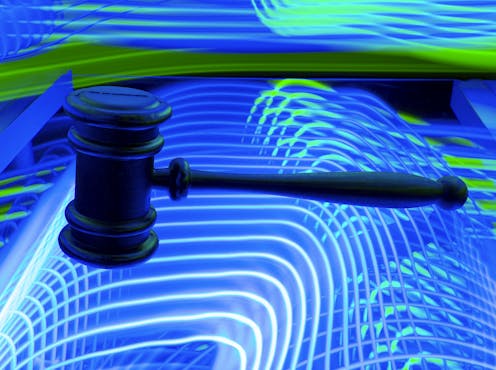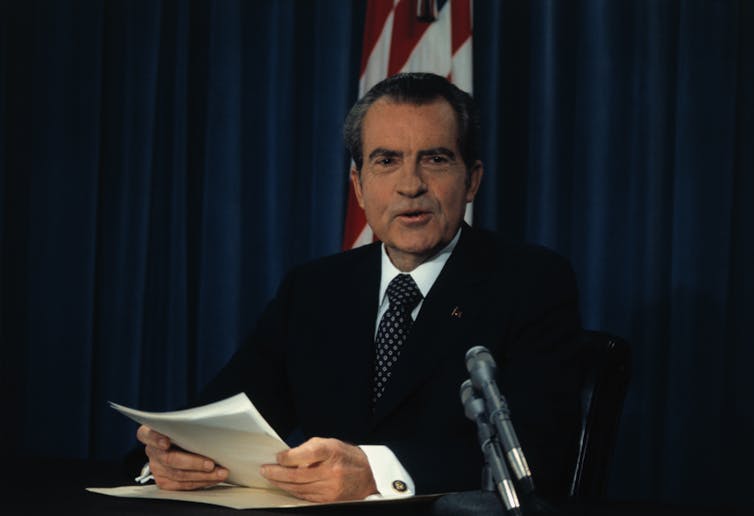When the Supreme Court said it’s important to move quickly in key presidential cases like Trump’s im
In 1974, the Supreme Court accepted, heard and decided a case within two months because the justices understood its importance to the public.

When former President Donald Trump’s attorneys argue before the U.S. Supreme Court on April 25, 2024, they will claim he is immune from criminal prosecution for official actions taken during his time in the Oval Office. The claim arises from his federal charges of attempting to overturn the 2020 presidential election results, but also may apply to the charges he faces over hoarding classified documents after leaving office.
No Supreme Court has decided this question, nor has any of its rulings said definitively what counts as an official act and what does not. Numerous commentators have called on the justices to decide the case rapidly.
But to the justices, and to me as a scholar of American politics and law, perhaps no commentator is as persuasive as the Supreme Court itself – in particular, in a ruling from 50 years ago.
Back then, in a case connected to the deepening Watergate scandal, then-President Richard Nixon claimed that all of a president’s conversations during his term in office were confidential and could not be subpoenaed into evidence by a court, even if they contained information relevant to a criminal prosecution.
In 1974, the Supreme Court accepted, heard and decided Nixon’s claim within two months, with Chief Justice Warren Burger explaining it had done so “because the matters at issue were of urgent public importance.”
So far, the court has acted more slowly in Trump’s case, but may yet heed its own words of urgency from the past.
A slowly unfolding inquiry
By 1974, the Watergate scandal had dragged on for almost two years, tearing the country apart. It was sparked by a burglary of Democratic Party headquarters in Washington’s Watergate Complex in May 1972 and mounting evidence that Nixon had orchestrated a cover-up.
In the summer of 1973, the highly publicized Senate hearings on Watergate publicly revealed the existence of tape recordings of Oval Office conversations. Access to the tapes became critical to establishing what Nixon knew about the break-in and when he knew it.
In November 1973, political pressure forced Nixon to release seven tapes to Judge John Sirica, who presided over a federal grand jury investigating Watergate. Leon Jaworski, whom Nixon had appointed special prosecutor, used those tapes to secure indictments of seven of Nixon’s top advisers for their efforts to cover up the burglary. The indictments were made public on March 1, 1974 – but secretly, Nixon was named an unindicted co-conspirator.

A rapid series of court decisions
Based on evidence from logs of visits to the White House, Jaworski identified 64 additional tapes that likely contained relevant conversations and persuaded Sirica to subpoena them. Nixon’s team appealed to the U.S. Court of Appeals. On May 24, 1974, Jaworski filed a request for certiorari before judgment, a rarely used legal mechanism asking the Supreme Court to get involved before the appeals court heard the case.
On May 31, six justices, including two Nixon appointees, granted Jaworski’s request and set oral arguments for July 8. One justice, William Rehnquist, recused himself because he had worked in Nixon’s Justice Department before being appointed to the court.
After oral arguments, all eight justices rejected Nixon’s claim of absolute executive privilege. They ruled there was probable cause that the subpoenaed tapes were relevant to a criminal case, found no indication that they would compromise national security, and were reassured that a judge would review them privately before divulging their contents.
The Burger court brimmed with big egos and petty rivalries. Nevertheless, all seven of its unrecused associate justices quickly joined the chief’s opinion, which was released on July 24. No additional concurring opinions muddied the legal waters.
Nixon had hoped that a divided court or an ambiguous ruling would allow further delay. But a unanimous ruling, penned by the chief justice he had nominated, convinced him to comply. “The problem was not just that we had lost,” he wrote in his memoirs, “but we had lost so decisively.”
Two days after the court’s ruling, on July 26, 1974, the House Judiciary Committee approved an article of impeachment against Nixon. One of its key pieces of evidence was one of the recordings the Supreme Court had ordered released. Called the “smoking gun,” it recorded Nixon directing his chief of staff to order the CIA to prevent the FBI from investigating the burglary. On Aug. 8, Nixon announced to the nation that he would resign the following day.
The Supreme Court had moved quickly, accepting the case at the earliest point it could have. That happened on May 31, with oral arguments 38 days later, on July 8. The court issued its ruling 16 days after that, on July 24. And just over two weeks later, Nixon was no longer president.
Trump’s delays
As events in Trump’s case unfolded in 2023, there were parallels to Nixon’s situation. When District Court Judge Tanya Chutkan’s rejection of Trump’s immunity claim was appealed to the D.C. Circuit Court of Appeals in December 2023, special counsel Jack Smith asked the Supreme Court to grant certiorari before judgment.
During John Roberts’ time as chief justice, the Supreme Court has frequently agreed with those requests. But in Trump’s case, the justices declined to do so, offering no explanation.
It wasn’t until Feb. 6, 2024, that the appeals court forcefully rejected Trump’s claim of immunity. Smith again asked the Supreme Court to move the case along quickly – and on Feb. 28, the justices agreed to review it.
They scheduled oral arguments for 58 days later, on April 25. That is already more time than had elapsed between the Supreme Court accepting and deciding the case in 1974. And 1974 was not a year with a presidential election.
The importance of speed
I am not the only one who believes the Trump case is of similar – if not greater – importance to democracy.
The arguments in each of these cases challenge principles of the system the founders created, of a limited government with checks and balances on executive, legislative and judicial power.
It’s not yet clear how soon the Roberts court will rule, but in 1974, the justices appreciated “the public importance of the issues presented and the need for their prompt resolution”.
Donald Nieman has received funding from the National Endowment for the Humanities and the American Council of Learned Societies.
Read These Next
The North Pole keeps moving – here’s how that affects Santa’s holiday travel and yours
There are actually two North Poles. One has been wandering over northern Canada and north of there for…
2 superpowers, 1 playbook: Why Chinese and US bureaucrats think and act alike
The men and women tasked with implementing policy are governed by the same incentives and constraints…
How rogue nations are capitalizing on gaps in crypto regulation to finance weapons programs
North Korea was behind a $1.5 billion digital bank heist in February 2025. Other countries are similarly…






